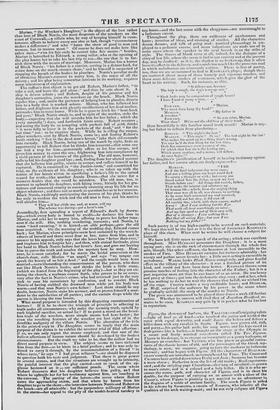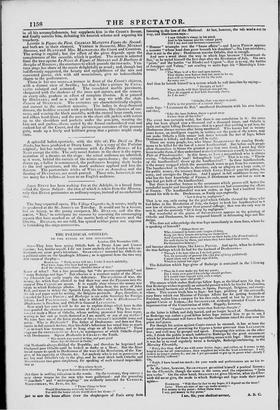Figaro,the ISIerettryof barters, the TALLEYRAND ofintriguingralets —light of heel as
of hand—who touched the guitar and wielded the razor with equal dexterity, and cold!. dance the bolero and deliver a billet-doux with any cavalier in Spain. Figaro, now grown old, dull, and pursy,—his guitar laid aside, his song mute, and his legs cased in drab gaiters like a butler,—is brum.tht on the stage at tire Olympic in a smart and lively musical comedietta called 7'he Two Figaros. Figaro in his dotage, is as strange an incongruity as a gouty harlequin, or Mercury on crutches : but VESTRIS, who has given us graceful carica- tures of the classic heroes of old, and the personages of the Greek my- thology, is now, we suppose, going to turn the moderns to ludicrous account ; and has begun with Figaro. All the characters of BEAuMAa- ctlms'comedyare introduced, metamorphosed by Time. The Count and Countess have settled down into a Derby and Joan ; Susanna has become a mere shrew ; I3arbarina is on the li-t of old maids ; Basil superannu- ated ; and the stripling page Chertibitio—that imp of mischief—is grown to man's estate, and is a colonel and a lady -killer. Ile it is who as- sumes the name, garb, and character of Figaro, and is in short hist double, for the purpose of carrying on an amour with a niece of the Count's, whom Figaro is plotting to get married to an adventurer in the disguise of a noble of ancient family. The mock Figaro is aided in his scheme by Susanetta, a cousin of Susanna, who inherits all the qualities of the arch waiting-maid ; and he not only eclipses old Figaro
in all his accomplishments, but supplants him in the Count's favour, and finally outwits him, defeating his knavish scheme and exposing his treachery.
LISTON is Figaro the First, CHARLES MATHEWS Figaro the Second; and both are in their element. VESTRIES is Susanetta, Miss MURRAY Susanna, and BLAND and Mrs. MACNAMARA the Count and Countess. The acting is capital ; but the effect of the piece depends upon the completeness of the ensemble, which is perfect. The music is selected from the two operas Le Nozze de Figaro of MOZART and Ii Barbiere di Seviglia of ROSSINI ; the overtures to which precede the two acts. YES- THIS sings her share of the music delightfully as usual; and, though but indifferently supported, the beauty and sprightliness of the airs and concerted pieces, rich with old associations, give an indescribable charm to the performance. There is but one scene—a terrace in front of the Count's chateau, with a distant view of Seville; but that is like a picture by CANA- LLTTI enlarged and animated. The tesselated marble pavement, chequered with the shadows of the trees and statues, and the scenery on every side, produce an effect of complete illusion. It is painted by HILDYARD; and as a work of art it may vie with the chefs- d'alivre of STANFIELD. The costumes are characteristically elegant, and correct to the smallest minutiae, The ladies in deep-flounced stresses, the boddice covered with pendent buttons, like clusters of cur- rants, and wearing the black mantilla, with the eternal large comb, rose, and silken head-knot ; and the men in the short silk jacket, with waists np to the shoulders and pockets under the arm-pits, wearing the hair-net and gacho—these, varied by the formal embroidered coat and cocked-hat of the Count, and the picturesque costumes of the peasant girls, made up a lively and brilliant group that a painter might study



























 Previous page
Previous page